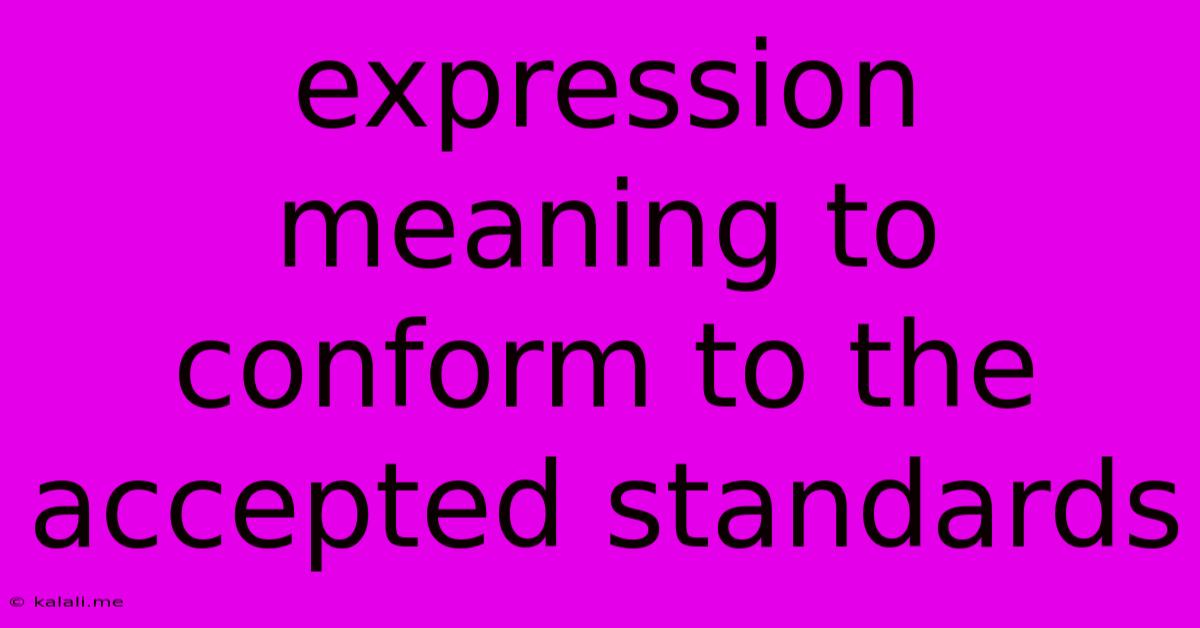Expression Meaning To Conform To The Accepted Standards
Kalali
May 21, 2025 · 3 min read

Table of Contents
Understanding Conformity: The Meaning of Aligning with Accepted Standards
Meta Description: This article explores the meaning of conformity, examining its various aspects, implications, and the subtle nuances behind aligning oneself with accepted standards of behavior and thought. We delve into the social pressures, individual motivations, and broader societal effects of conforming.
Conformity, at its core, refers to the act of matching attitudes, beliefs, and behaviors to group norms. It's about aligning oneself with the accepted standards of a particular group or society. This isn't necessarily a conscious decision; it can be a subtle, unconscious process influenced by social pressures, the desire for belonging, or a belief in the validity of group norms. Understanding the complexities of conformity requires examining its different facets and implications.
Types of Conformity
There are several key types of conformity, each driven by different motivations:
-
Compliance: This is the most superficial form of conformity. Individuals outwardly comply with group norms to gain approval or avoid punishment, but their internal beliefs may remain unchanged. Think of someone publicly agreeing with a viewpoint they privately disagree with to avoid conflict.
-
Identification: Here, conformity stems from a desire to be associated with a particular group or person. Individuals adopt the group's norms because they identify with the group's values and want to be a part of it. This type of conformity is more deeply ingrained than compliance.
-
Internalization: This is the deepest form of conformity. Individuals genuinely accept the group's norms and integrate them into their own belief system. Their behavior changes not because of pressure or a desire for affiliation, but because they truly believe in the validity of the group's standards.
The Social Psychology of Conformity
Several influential studies, such as Asch's conformity experiments, have demonstrated the power of social influence on individual behavior. These experiments highlight how individuals will often conform to obviously incorrect group judgments to avoid standing out or feeling ostracized. The fear of social disapproval is a powerful motivator for conformity.
The strength of group cohesion also plays a significant role. The more cohesive a group, the greater the pressure to conform. Similarly, the size of the majority group influences conformity rates; conformity increases with group size, but plateaus after a certain point.
Positive and Negative Aspects of Conformity
Conformity isn't inherently good or bad. It has both positive and negative consequences:
Positive Aspects:
- Social Order: Conformity helps maintain social order and stability. Shared norms and expectations facilitate cooperation and reduce conflict.
- Social Cohesion: It fosters a sense of belonging and strengthens group bonds.
- Efficiency: Following established norms can streamline processes and improve efficiency in various settings.
Negative Aspects:
- Suppression of Individuality: Excessive conformity can stifle creativity, innovation, and critical thinking.
- Groupthink: The desire for conformity can lead to poor decision-making, as dissenting opinions are suppressed.
- Social Inequality: Conformity can reinforce existing social inequalities by perpetuating biased norms and expectations.
Navigating the Pressure to Conform
While conformity is a natural human tendency, it's crucial to develop the ability to critically evaluate group norms and make independent judgments. This involves:
- Self-awareness: Understanding your own values and beliefs.
- Critical thinking: Questioning assumptions and evaluating evidence objectively.
- Assertiveness: Expressing your own views confidently and respectfully, even when they differ from the majority.
In conclusion, conformity is a multifaceted social phenomenon with both beneficial and detrimental implications. Understanding its nuances, motivations, and consequences is vital for navigating social interactions and fostering a healthy balance between individual expression and social harmony. The key lies in finding a balance—embracing the positive aspects of conformity while remaining mindful of its potential downsides and cultivating the courage to deviate when necessary.
Latest Posts
Latest Posts
-
Salesforce Ampscript Evaluate Decimel Greater Than 0
May 23, 2025
-
Adobe Illustator Cant Use Paint Brush
May 23, 2025
-
Can You Point Us To The Right Person
May 23, 2025
-
Dbus Failed Connection 1 61 Is Not Allowed
May 23, 2025
-
Format Usb To Ext3 Mac Os
May 23, 2025
Related Post
Thank you for visiting our website which covers about Expression Meaning To Conform To The Accepted Standards . We hope the information provided has been useful to you. Feel free to contact us if you have any questions or need further assistance. See you next time and don't miss to bookmark.